European castles are undeniably magical. Out of all of Europe, Germany boasts the most impressive selection of castles, these magnificent structures widely considered to be the nation’s crown jewels. Germany is home to 2,000+ castles, according to some sources
German castles originate from 9th to 19th centuries, the time when the Great Age of Castles began. Castles embrace the necessity of nations to gain protection against other nations’ invasions, but also served as residences of royal families. These amazing buildings typify tactical and solid rocky constructions, built by kings and emperors to guard nations’ territories in times of war and to impose rule over populaces in peacetime.
German Castles evolved in the “Medieval Ages”, the fall of Ancient Rome and the beginning of the Renaissance Area in the 14th Century, considered as an era of art and architecture. The architecture grabs a mixture of towers and fortified walls, with amazingly decorated interiors and exteriors, situated in the high peaks of mountains and valleys, nearby waterways, enabling a full overview of the surrounding territory.
Today Germany enjoys a brilliant heritage of Castles, counting around 2,100 castles distributed nationwide. Behind the doorways of these impressive castles, a very bright and amusing history is to be exposed. Around 100 years ago, not so long ago in relative terms, kings, emperors and their families were there, lived there and operated there. Historical resolutions were agreed there, while many soldiers lost their lives there, protecting their nation from invaders’ attacks.
In our day, these spectacular ancient buildings serve as cultural objects, museums, guesthouses and antiquity references.
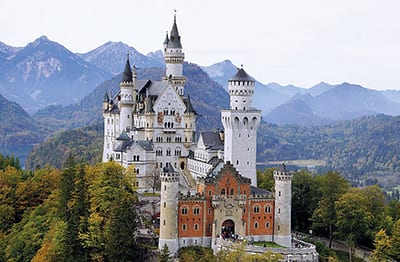
NEUSCHWANSTEIN CASTLE
Neuschwanstein was the dream castle of King Ludwig II. Built during the late 19th century, the Romanesque style makes it look like a romantic fairy tale castle. It has been an inspiration to many, including Disney’s Magic Kingdom Castle.
Ludwig was thought to be living in his fantasy world. He was a very shy dreamer, with a sense for the artistic. He dedicated Neuschwanstein to Richard Wagner, a German composer. Ludwig was very interested in Wagner’s work, and his operas seem to have served as an inspiration for the castle. Unfortunately, King Ludwig never got to see his dream castle completed, having died while construction was still underway.
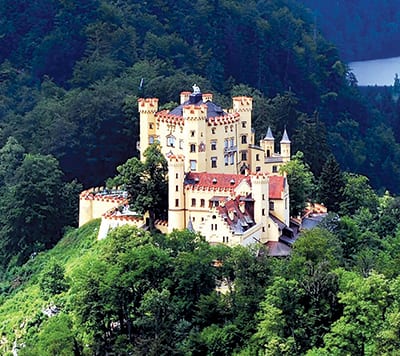
HOHENSCHWANGAU CASTLE
The yellow Hohenschwangau castle was built in the 19th century just before Neuschwanstein and was supposed to resemble the medieval castle that used to stand on the same location. This is a castle where Bavarian kings had actually spent time; it used to be their summer residence and Ludwig probably spent some happy childhood years there.
What we found very interesting about Hohenschwangau was that the family had actually lived there for certain periods of the year and that it was, therefore, a working castle.
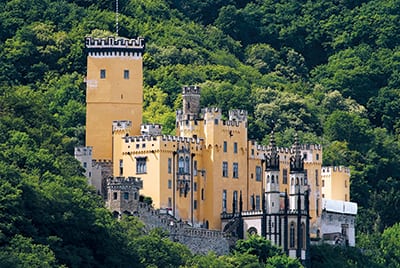
SCHLOSS STOLZENFELS
The Rhine Valley is a gorgeous region that’s only a short drive from Frankfurt. One of the most attractive castles in the Rhine Valley is Schloss Stolzenfels, which was the Gothic-Revival renovation of a medieval castle by the King of Prussia. It may not be the most famous castle in Germany, but it is a castle straight from a fairy tale. Stolzenfels’ view over the valley, as well as its ornate gardens, make it one of Germany’s most spectacular castles.
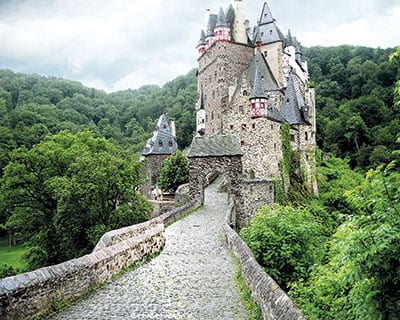
CASTLE ELTZ
Castle Eltz is slightly further away from the Rhine Valley than other castles. Eltz originally had separate buildings belonging to a few families, though one of the original families now owns all the buildings. The family still keeps one of the towers private, as part of their private apartment, which makes this castle quite different from others. In particular, it feels less medieval, and more like someone’s luxurious apartment that happens to date back hundreds of years.
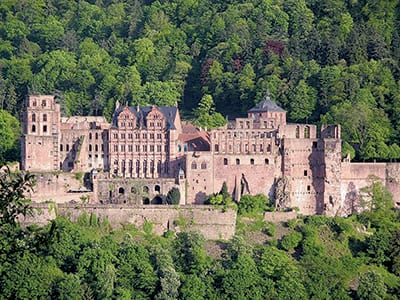
HEIDELBERG CASTLE
Heidelberg Castle, located within walking distance of Heidelberg’s downtown area, is a beautiful partially reconstructed castle that sits on the side of a hill overlooking the beautiful old town. It isn’t the best preserved and its walls aren’t covered with paintings, but its gorgeous pink stone and partial demolition gives it the feeling of wandering into a forgotten land. Heidelberg contains the world’s largest wine barrel, holding 57,853 gallons! It’s so massive that you can climb stairs and wander around the barrel on a surrounding deck.
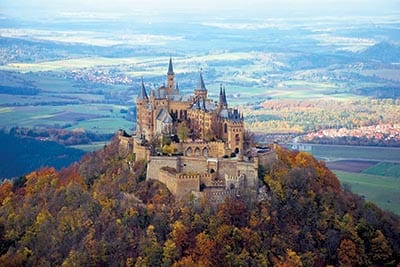
HOHENZOLLERN CASTLE
Burg Hohenzollern was built somewhere between 1846 and 1867. This site is the ancestral seat of the Imperial House of Hohenzollern, and the present day structure is actually the third castle built on the spot. The castle, set alone atop an impressive hill, is one of the most visited castles in Germany. Highlights include St Michel’s chapel and the famous Hohenzollern Crown, a decadently bejewelled piece adorned with, among other gems, a diamond cross,142 rose-cut diamonds and a massive sapphire.
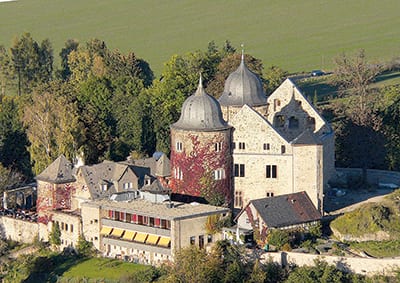
DORNRÖSCHENSCHLOSS SABABURG (SLEEPING BEAUTY CASTLE)
Located very close to Munden and Gottingen, this isolated 600+-year-old castle is situated deep in a forest, off the main road. Also known as Sleeping Beauty’s Castle, it was turned into a hunting lodge in 1765 and was frequently visited by the Brothers Grimm. Like many castle hotels, it has rooms in both the original section (in this case a romantic tower) and a newer wing. The modern rooms have been skillfully added to part of the castle ruins. An animal park below is populated with beasts boasting very old lineages, extending as far as the eye can see. It is Europe’s oldest animal park/zoo.
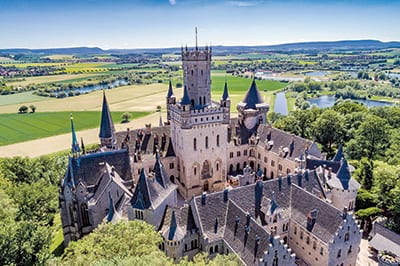
SCHLOSS MARIENBURG
Schloss Marienburg was built by King George V of Hannover for his wife, Queen Marie, as a birthday present. One of the few remaining castles in Germany unaffected by the war, it still holds all of its original interior furniture. The pieces are immaculate, and the secrets they hold are incredible. Much of the exterior architecture is reminiscent of Disney princess castles.
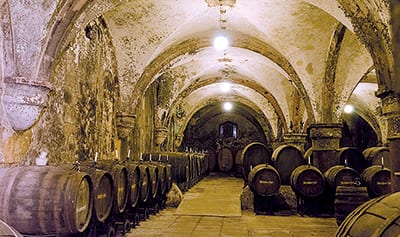
EBERBACH CASTLE / EBERBACH MONASTERY
Eberbach Monastery was one of the first places to start producing Pinot Noir in Germany. There is a sense of going back in history as you stroll through the monastery’s timeless Roman arches. The Cistercians had a very simple lifestyle, which is evident from the strong wooden arches with bare furnishings. A church is central to the workings of the monastery and the Roman architecture will make you fall in love with its simplicity. The dining hall of the Lay Brothers is where all the action used to take place. The wooden wine presses of the 17-19th centuries are still visible. Although the monks were known for their austerity, the Baroque period saw them showcase their worldly wealth. The Baroque residence was one of the most elegantly decorated rooms in all of medieval Europe.